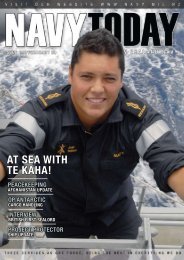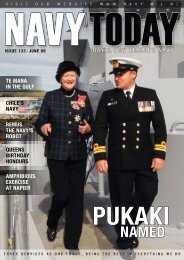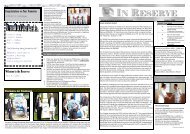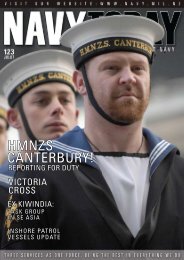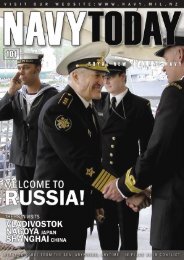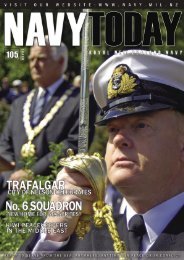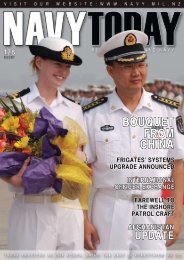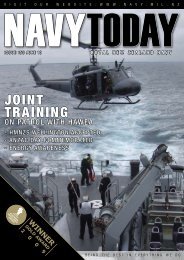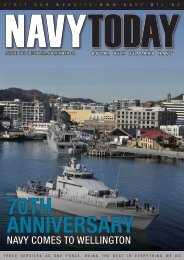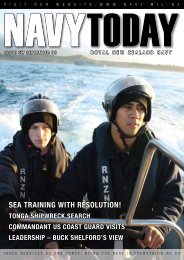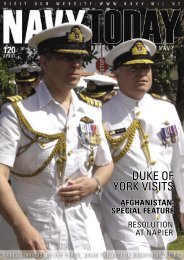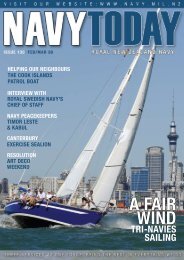Aug-Sep 2013, Issue 174 - Royal New Zealand Navy
Aug-Sep 2013, Issue 174 - Royal New Zealand Navy
Aug-Sep 2013, Issue 174 - Royal New Zealand Navy
You also want an ePaper? Increase the reach of your titles
YUMPU automatically turns print PDFs into web optimized ePapers that Google loves.
Warrant Officer ofthe <strong>Navy</strong> Lennie ShailesTop: Proposed site for internal Seamanship Training AidsAbove: Proposed site for waterside trainerOpposite page: The RAN version of a seamanship training facilityFeedback from the ships has been extremely positive, highlightingthe increased confidence Command has when personnel new to aship undertake seamanship evolutions. Trainees are also positiveas it better prepares them for what can be challenging tasks,especially when they are outside the realm of their trades.The most exciting and visible progress for the RSE programmeis the approval for construction of a mock ship emulator andwaterside trainer. The Seamanship Training Aids project is nowwell underway to provide a purpose-built internal and externaltrainer, allowing a realistic working environment for our people totrain on. The internal facility will house a scale model of an InshorePatrol Vessel forecastle, midships and berthing structure. Thewaterside trainer will have a Vest Davit, Hiab crane, pilot ladderand swimmer-of-the-watch gantry to allow real time launch andrecovery of our seaboats.It is expected that the trainer will be ready for use mid-to-end2014.The other pieces of the puzzle around governance, standards andmeasurement of seamanship excellence are all being worked onto ensure that safe and effective seamanship is ingrained in ourculture. Make sure you’re part of the solution, ensuring safe andeffective seamanship right across our Fleet.Any comments about the RSE Programme can be directed to LT CDRAnge Barker, RNZN. angela.barker@nzdf.mil.nz or 397-8271.WON REPORTIf I take you back to the eighties, networking wassomething we did at Inter Services sports tournaments—although back then it was called something else. Itwasn’t till later that I started to think and realise howimportant the contacts I’d made through sport really were.So what changed? Well I guess I realised that the more wework in either an International or Tri-Service environment,many things and information are made easier to acquireif you already have a contact within that area or knowsomeone who can help you.I do not know anyone who hasn’t met someone from eitheranother Service or a civilian working for the Defence Force.The current intake of BCTs have met and been instructedby Mr Harris at SATU. AMT (P) Daniel Wilson talks to PTEJackson of Ship’s Amphibious Load Team (SALT) on CAN atscran and ASA Leighton Kopua, who’s currently assisting outat Papakura, all conduct networking on a daily basis. Theseare just a few people who come to mind but I’m sure youcan think of others.So what is so important about networking? As the DefenceForce works towards Future 35 over the next 20 years,networking and having contacts within other Services orcivilian organisations is going to be more important as westart to coordinate things. The other reason that comes tomind is, as we move up through the ranks we rarely keepthe same job or work in the same place for more than two tothree years. This makes it difficult at the start as you don’tknow all you need to, and these people will help you.My challenge for you today is to talk to someone new andstart creating your own network. Having someone to talkto on a good day is easy, it’s when it’s a bad day that yournetwork will really pay off.No matter where you are or whatever you’re doing have funand “Look after your mates”.Top: The Master Chief of the Seventh fleet (CMDCMTyler Schoeppey) was a recent visitor to Wellington.Networking from left WOWT Wayne Morris, WOMT (L)Howie Rait, WON Lennie Shailes, CMDCM Schoeppey,WOEWS Darby Allen and WOCH Shane Reeves.WON Report19



